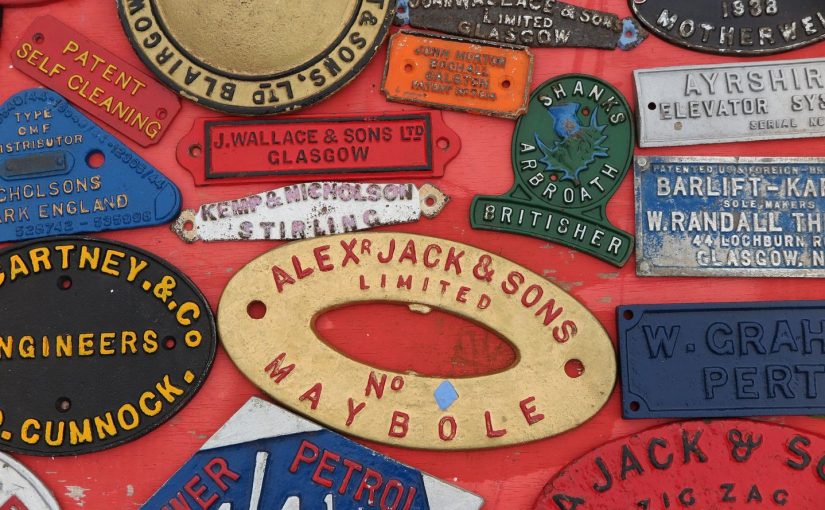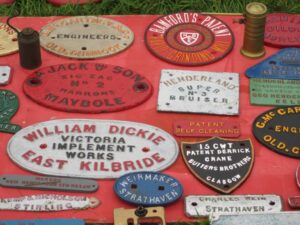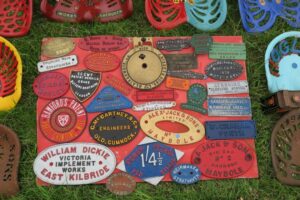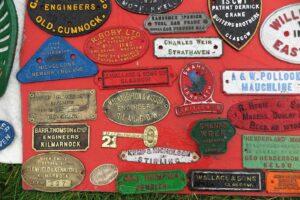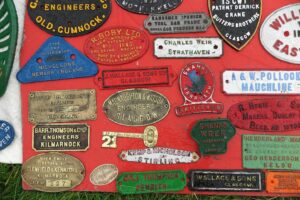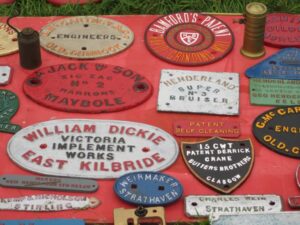An important section of the Royal Highland Show, yesterday, and today, is the new implements entered for the “New Implement” award. Entries reflect what was new, innovative as well as solutions to try to remedy contemporary problems in Scottish agriculture. There was a diverse range of implements and machines entered for this award in 1935. Some were to address long-standing issues, others to deal with current problems. Some reflected the interests of their inventors, having a great idea that would make an important change to Scottish agriculture.
The Scotsman provided a detailed account of the entries for the “New Implement” award in its pages of 18 June 1935. This is what it wrote:
“Farm implements and machinery described
New implements
The competitive section
Each year the Society offers a silver medal for new implements, and on this occasion 17 exhibitors have entered implements and other labour-saving devices in this competitive section. The entries are to be found among the exhibits of the manufacturers’ stands, and while some of them are “old friends”, many show improvements in detail of existing implements which bring them into the category of “new implements”. Small and simple as some of the inventions may appear, they are of considerable importance. One of the novelties of last year was a bracken cutter, for which a medal was awarded to an Ayrshire firm. This year another bracken cutter has been entered, but before the judges can appraise its value it will have to be seen at work.
The judges of new implements, Messrs J. P. Ross-Taylor, Mungoswells, Duns; James Paton, Kirkness, Glencraig; and John E. B. Cowper, Gogar House, Edinburgh, began their inspection yesterday, accompanied by Professor R. Stanfield, A.R.S.M.; M.Inst.C.E. F.R.S.E., consulting engineer, and Mr John B. todd, B.Sc., PhD., M.I.Mech.E., Edinburgh, assistant consulting engineer.
“Scottish bracken cutter”
In these days when the spread of bracken has been causing serious damage to sheep flocks by giving cover for maggot flies, and when methods for its eradication are being urged upon the Government, attention will be directed to the “Scottish” cutter which has been invented by Mr Thomas Scott, Thorn Farm, Bonnybridge. The cutter consists of a special scythe, to which is attached a chemical sprayer-a docker’s improved lamp-carrying a chemical preparation-the principal ingredients being paraffin oil and naphthalene, with benzolene, cresol, or other tar oils. The chemical mixture is allowed to drip on the blade of the scythe, and by slight movements of the hand is spread along the blade. By cutting a very short stubble the chemical mixture is permitted to reach and kill the fronds. It is also maintained that the inclusion of tar oils in the mixture will tend to eliminate flies.
Glasgow firm’s pasteuriser
The question of the pasteurising of milk has been acutely raised in many quarters, and there are some who advocate that all milk which is not produced from Grade A (![]() .) or certified herds should be compulsorily pasteurised. With this contingency in view, Messrs G. D. L. Swann & Son, Abercorn Street, Glasgow, have designed the “Calorilac” Pasteuriser, which is entered as a “new implement”. The “Calorilac”, which can be made in various sizes from 20 gallons upwards, consists of inner and outer containers. The inner one is made of special stainless steel, all corners rounded to give a special smooth and hygienic surface. The joints in this container are welded, ground, and polished. The outlet tube is welded to the inner tank, and passes through the outer jacket and a gland. The two containers are lapped together. The required temperature is obtained by heating water with steam between the containers. There is, it is stated, no danger of pressure between the walls of the containers. The agitation is simple and clean, and no grease from bearings can drop into the milk. The agitator can be operated by hand, motor or steam. The “Calorilac” has been designed with a minimum height, so that it may be conveniently placed above the cooler even in low-roofed tooms, and this save pumping after the milk is heated. The covers are made of stainless steel. A recording thermometer is also fitted.
.) or certified herds should be compulsorily pasteurised. With this contingency in view, Messrs G. D. L. Swann & Son, Abercorn Street, Glasgow, have designed the “Calorilac” Pasteuriser, which is entered as a “new implement”. The “Calorilac”, which can be made in various sizes from 20 gallons upwards, consists of inner and outer containers. The inner one is made of special stainless steel, all corners rounded to give a special smooth and hygienic surface. The joints in this container are welded, ground, and polished. The outlet tube is welded to the inner tank, and passes through the outer jacket and a gland. The two containers are lapped together. The required temperature is obtained by heating water with steam between the containers. There is, it is stated, no danger of pressure between the walls of the containers. The agitation is simple and clean, and no grease from bearings can drop into the milk. The agitator can be operated by hand, motor or steam. The “Calorilac” has been designed with a minimum height, so that it may be conveniently placed above the cooler even in low-roofed tooms, and this save pumping after the milk is heated. The covers are made of stainless steel. A recording thermometer is also fitted.
Small threshing mill
Mr James Crichton, millwright and engineer, Turriff, has on view a one-belt thresher, G. M. type, which has an approximate capacity of 32-40 bushels per hour. The thresher is fitted with a medium speed drum of 27 in. diameter, having cast-steel centres and six beaters, and is fitted with specially designed short-pegged beater plates, which do not bruise the straw. As only one small belt is required to operate the machine, a large number of wearing parts are eliminated, and much less power is required. Owing to its balance, the thresher needs practically no fixing down.
Binder divider attachment
Mr John Henderson, Meadownay, Maybole, exhibits a Binder Divider Attachment, made by Messrs Archibald Hunter & Sons, Maybole. The attachment consists of a sharpened steel blade about 3 feet 6 inches long, mounted on the top if the extension divider of a binder. When not in use the blade folds sown on the inside of the divider by means of a spring arrangement on the rear pin, a handle for the purpose being fitted to the blade. The attachment is intended to deal with laid cereal crops. However, badly a crop is laid, the attachment will cut through it, thus reducing the draught on horses or tractor, and easing the strain on the binder, with a consequent saving of time and labour. Where normally three horses would be required, and have a heavy task in dealing with a laid crop, two horse, with the aid of this attachment, are sufficient to deal with the work. In addition, delay and danger from choking are entirely obviated. The divider attachment – whatever the state of the crop – leaves a clean-cut face, and thus considerable labour is saved.
Messrs William Henderson & Sons, engineers, Mauchline, have entered the “Collins” Power-Driven Rotary Scarifier, invented by Mr Charles M. Collins, and made by the exhibitors. This scarifier is power-driven by a vertical rotor, and specially designed time-holding bars are carried. The bars are mounted so as to give a vertical movement. To compensate for undulations on the surface of the land, the mounting is also such as to take up the influence of torque. The tines are of coil spring type, and the tine-holders are designed to accommodate a plurality of tines. In operation the implement is propelled along the land surface, either by attachment to a power-driven bracken cutter or to an agricultural tractor.
Laid crop attachment
Alexander Jack & Sons (Ltd), agricultural implement makers, Maybole, have entered a laid crop attachment for mowers, reapers, and binders invented by Mr Charles T. McFadzean, kirklands Cottage, Maybole. The invention consists of an attachment to a divider, or shredder, for dealing with tangled or laid crops. The attachment is in the form of a longitudinal reverse knife, detachably secured to the divider in an inclined position rising upwards towards the rear. The knife has two parallel, straight, or slightly curved longitudinal, cutting edges, terminating in bevelled or inclined ends, forming four inclined cutting edges, two at each end of the knife. By reversing the knife, any one of the four inclined cutting edges can be brought to the front uppermost position for use in conjunction with one of the two straight cutting edges, thus dividing or separating and severing tangled or laid crops.
The same firm exhibit a new combined (convertible) general purpose coup cart and hay ricklifter, also invented by Mr Charles T. McFadzean. This new machine is the latest advance in the application of Dunlop pneumatic wheel equipment to the needs of the agriculturist.
Cattle drinking bowl
Mr William Kirkwood, Queenswell Lane Works, Forfar, exhibits a valve for cattle drinking bowl, which has been designed to give a minimum of trouble. The flow of water through the valve is practically shut off before the rubber washer meets the valve seat, and thus the usual bounce on the valve, caused by the reaction of the water flow being suddenly shut of, is obviated. Further, as the valve is able to work under semi-high pressure, it prevents the bowl overflowing when cattle play with the bowl tongue. This is die to the fact that the tongue must travel an appreciative distance before the full flow of water commences.
Wire-winding machine
Mr Thomas Nimmo, Braehead, Fauldhouse, West Lothian, exhibits a barbed and plain wire-winding machine invented and made by the exhibitor. It consists of a spindle, fitted with a cranked driving handle, together with fittings suitable to take a standard type of barbed wire reel.
The purpose of this machine is to simplify the handling of reels of barbed wire, and is especially useful when rewinding wire from temporary fences.
New type of ricklifter
Messrs A. & W. Pollock, engineers, Mauchline, show a ricklifter and low loading float combination. This is. Anew type of ricklifter, fitted with “Dunlop” special pneumatic wheels and roller-bearing axle. It is so designed that it can be instantly converted into a general purpose low loading float or cart, and thus it can be used throughout the whole year.
Pneumatic harness
McCubbing Pneumatic Harness Co., Linwood, Dalbeattie, exhibit pneumatic harness. Invented by Mr Robert McCubbing, and made by the exhibitors. It is claimed that with this harness the horse enjoys greater ease and comfort, as the shock-absorbing qualities embodied in the pneumatic principle are given full application. As the cushions are capable of being inflated or deflated a degree of adjustment with regard to the fitting or weight of load, &., is now obtainable.”
